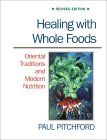

Acupuncture and Qi
Encounters with Qi, by David Eisenberg.
This fascinating book is an allopathic physician's story of his time as a medical exchange student in China and his experiences with Chinese medicine. Along the way, Eisenberg discusses the Chinese concept of Qi and its role in acupuncture as well as Chinese culture.
In this book, Haas offers guidelines from Chinese medicine and other principles (such as Ayurveda and macrobiotics) for maintaining healthy eating habits in today's world. In accordance with traditional eating practices, it is structured around the seasons to take advantage of ingredients at the peak of flavor and nutrients. 
Between Heaven and Earth, by Harriet Beinfield and Efrem Korngold. 
This book by two acupuncturists is a good introduction to the theory and style of Chinese acupuncture that's currently most widely practiced in the United States. It does not go into Japanese or other styles of acupuncture. It is written for the layperson who hasn't had previous experience with acupuncture. Nicely written and easily understandable.
Understanding Acupuncture, by Stephen Birch and Robert Felt. 
Understanding Acupuncture has an extensive discussion on the history of acupuncture, and describes different theories on how acupuncture works as well as how they might be tested empirically. This book does discuss different styles of acupuncture including Toyohari, the style I specialize in. The book is written for the layperson, but has such a wealth of information it is very worthwhile for the practitioner as well. I am quite partial to this book, as one of the authors is Stephen Birch, one of my teachers.
Voices of Qi, by Alex Holland. 
This short but useful book gives an excellent description of Chinese acupuncture as it is practiced today in the United States. It is written in simple, plain language for the layperson. One of the clearest and easiest books to understand for someone new to Chinese medicine.
Staying Healthy with the Seasons, by Elson Haas. 
In this book, Elson Haas gives an introduction and illustration of some of the basic tenets of Chinese medicine, including the Five Phases, and how to live according to them to promote health and well being. Haas discusses not only the theory but gives concrete examples of how to apply it to your life. Written for the layperson.
The Web that has no Weaver, by Ted Kaptchuk. 
A good text on the basic Zang-Fu principles of Chinese medicine, which form the theoretical basis of Chinese acupuncture as it is commonly practiced today. Understandable to a layperson, but slightly on the technical side.
Diet and Chinese Medicine
The Tao of Healthy Eating, by Bob Flaws.
This book is a useful introduction to eating according to the dietary principles of Chinese medicine. Short and simple, but with a wealth of information.
Healing with Whole Foods, by Paul Pitchford. 
This is unquestionably the best book on dietary principles from Chinese (and other alternative) medicine principles in the english language. Very detailed and comprehensive, and very well-written. An indispensible reference for practitioners, but understandable to most people. A great book for laypeople and practitioners alike.
The Healing Cuisine of China : 300 Recipes for Vibrant Health and Longevity 
This book provides a large number of good-tasting recipes prepared according to the principles of Chinese medicine. It includes a very good introduction to these principles, and has recipes for different kinds of conditions.
A Cookbook for All Seasons: A Healthy Eating Plan for Life, by Elson Haas and Eleaonora Manzolini.

Introduction to Meridian Therapy, By Shudo Denmei and Stephen Brown.
Excellent and thorough introduction to the basic principles of Japanese meridian therapy. Detailed descriptions of such basic information as how to take the pulse meridian therapy style. Another must have for those interested in practicing Japanese acupuncture.
Chasing the Dragon's Tail, by Yoshio Manaka and Stephen Birch.
This book describes Manaka's 5-step treatment protocol, and includes a detailed discussion of a a host of symptomatic treatment methods, as well as a model for understanding acupuncture.
Five Elements and Ten Stems : Nan Ching Theory, Diagnostics and Practice
by Kiiko Matsumoto, Robert L. Felt (Editor), Stephen Birch

This book both reviews the classical literature on the five elements (which form the basis of Japanese meridian therapy today) and provides a number of practical suggestions for how to apply the theory to one's clinical practice.